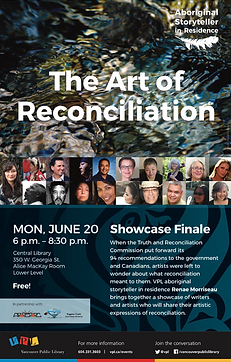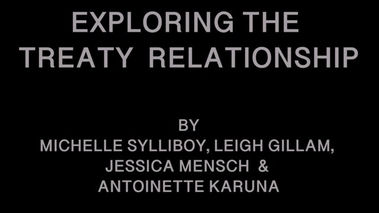

BIO
Three-time award winning author and Interdisciplinary artist Michelle Sylliboy is a two-spirit L'nu/ Mi'kmaq Artist born in Boston, Mass who was raised on un-ceded territory in We'koqmaq Unama'ki. She gathers much of her inspiration from personal tales, the environment, and her komwejwi'kasikl language. Her Interdisciplinary art practice led her to collaborate with emerging and professional artists. A PhD Candidate Michelle is working on her Philosophy of Education Doctorate Degree dissertation at Simon Fraser University where she combined her Interdisciplinary art background using Mi'kmaq Komqwejwi'kasikl language as her inspiration. Michelle is currently embarking on a new adventure in bringing the arts to the seven districts of the Mi'kmaw (L'nuk) Nation. She was long listed for the 2022 Sobey Award. Winner of the Arts NS 2021 Indigenous Artist Recognition award and the 2020 Indigenous Voices Award.

Professional Art History
The following is a list of all past professional experiences in the career of Michelle Sylliboy Mi'kmaq Artist. Each role has been unique and has contributed specific elements to their personal and professional development. For additional information see linktree


Kiskajeyi - I am Ready by Michelle Sylliboy
Book Launch /Komqwejwi'kasikl & Art Exhibition
March 31st, 2019- April 30th 2019
My first book of Komqwejwi'kasikl poetry titled Kiskajeyi - I AM READY published by Rebel Mountain Press is now available at rebelmountainpress.com and online see list.
Kiskajeyi is now available as an ebook available at amazon
Odilo (US libraries)
Hoopla
Kobo
Amazon.com -Kindle
Amazon.ca -Kindle
Fanship
Baker & Taylor (Libraries only)
Cloud Library by Bibliotheca
De Marque
Hoopla
Follet/ Overdrive
Apple
Barnes & Noble
Gardners ( UK) TBA

Capilano Review Poetry contributor
November 2017
Capilano Review poetry title "The Art of Reconciliation" The incredible book is now online.

2017 Unsettled, Group Exhibition
Unsettled video short is a collaboration with cellist Heather Hay.

Yellow Medicine Review
Spring edition 2018
The R-E-S-P-E-C-T Issue
Guest edited by Janet Marie Rogers with cover art by Israel Francisco Haros Lopez,

June 2016 The Art of Reconciliation, Lead Artist Vancouver Public Library.
In collaboration with Storyteller in Residence Renae Morriseau. The Art of Reconciliation evening
brought together local Vancouver Artists to respond to the 94 recommendations of the Truth and Reconciliation Process. By asking the tough question. What does reconciliation mean to you as an artist?

First American Art Magazine
February 24,2018
Interviewed by Matthew Ryan Smith and First Publication of
my Mi'kmaq Hieroglyphic (komqwej'wikasikl) poem
Visual Arts News - Spring 2019: EXPANSE
SPRING 2019
@Art/Events/Posters


@
@

@

@
Unearthing L'nuk ways of being
My art practice when teaching is anchored in the L'nuk philosophy of non-interference: an Indigenous worldview that engages the learner on multiple levels of how one sees and grows with the world. This worldview has served me throughout my existence along with gentle nudges by elders, aunties, uncles and cousins, and an ever-expanding community. I may sum up the L'nuk philosophy of non-interference as thus: follow the process, pay attention to the process, and allow and support what wants to emerge. This philosophy represents an ultimate statement of respect for Life and Reality. In an age wherein technology-driven rational dominates and massively interferes with reality has taken over First World thinking, the L'nuk way of thinking has been further marginalized. It is my intention to reintroduce and infuse the L'nuk philosophy of non-interference when teaching art. Additionally, it is my intention as an L'nu artist to teach that Indigenous worldviews, such as L'nuk, are also about understanding the history of land, language, community, and healing are all interconnected. We live in an age where critical thinking is often mistaken for judgment. Part of my artistic philosophy is to contest this mistaken notion. I share the following ideas about critical thinking as a trained and practicing artist. These ideas resonate closely with the L'nuk philosophy, as well. Critical thinking is dialogic, which involves co-emergent creativity amongst participant-learners. It allows the artist and viewer to engage in a dialogue that wants to emerge from the moment when creativity wills the artist to create his/her first work of art. Working with our hands and our mind is a gift anyone is capable of achieving, regardless of what background we were raised in, as long as we have a gentle guide that enables capacity building that supports different modalities. By creating a “safe-enough” space—the first step that a gentle guide takes, the artistic practice is nurtured and looked upon as the “critique of the soul.” This critique takes the form of channeling and facing our biggest fears, and making “something from nothing” in a time frame that suits our mindset. Co-incidentally, this also represents L'nuk code of ethics put into action. Such action, whether in teaching or making art, facilitates life processes whereby interconnectivity of everything becomes perspicacious to the participant-learner. Approaching art projects with no pre-conceived notions, but with well-prepared minds, the goal of artist is to work with students as their guide towards a journey that wants to unfold. When you engage in a dialogue with your student, they learn the art of creating simply by talking about their own process. It is in this manner that my best instructor in my art school at Langara College taught me the beauty of broken pottery shortly after it came out of a kiln. My short-lived devastation suddenly turned into another way of transforming a work of art. It was not broken: it was a new way of looking at art. That experience reminded me of what my elders passed on to me when I was younger: to always leave a mistake in the works of art, with which you remember that life is not always perfect. That teachable moment allowed me to teach sculpture using Indigenous pedagogy and ontology as a way to teach Indigenous worldview effortlessly. Knowing these ancient teachings made it easier for me to nurture prior knowledge in each student and to acknowledge that things do not always happen as we planned, and that everything is interconnected. L'nuk non-interference code of ethics is about putting aside your urge to tell someone what to do in contrast to supporting someone with his or her creative process. Teaching from an Indigenous perspective allows the student to understand and embody many ancient or indigenous philosophies, such as L'nuk in a manner that gently expands their artistic limitations without judgment. Art is a catalyst that moves you between worlds, be it the business world or the teaching profession. Whatever world you decide to be in professionally, having a background in the arts will allow you to engage the world on many different levels. Such has been my experience, whether in engaging with my art and education colleagues, and students or in working with hundreds of people at a conference as their honoured guest. Thus, into my teaching, I will bring my combined background of artist training and L'nuk philosophy, from which I will teach my students to work with a process that challenges them to look at things beyond their capabilities and differently from all angles. It is my intention to create a dynamic and creative educational experience for all students, where we are able to be with diverse communities of peoples as participants in meaningful relationships based on learning, collaboration, and community building and healing.































